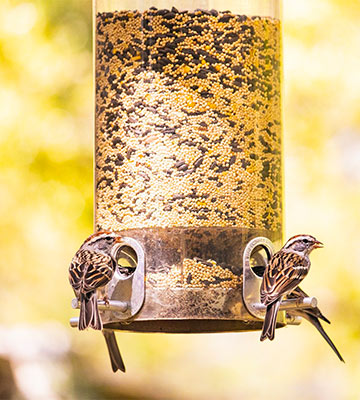Feeding birds in winter gives them a helping hand to face the cold weather in good conditions. To do this, place feeders in your garden or hang one on your balcony. There are different types of feeders to choose from, depending on your tastes, the food you want to offer and the type of birds you want to attract.
Contents
Why install a bird feeder?

A bird feeder for your garden birds.
With the exception of a few birds that feed on the ground, most birds (chickadees, goldfinches, robins, nuthatches…) prefer to peck at a feeder placed high up. Installing this type of feeder is the best way to attract many birds to your garden or balcony. You will be able to observe their comings and goings at your leisure, especially if you have placed your feeders in full view from your windows.
In winter, installing bird feeders is also – and above all – giving your winged friends a valuable boost to help them survive. This is a difficult season for them, as food is scarce in nature just when they need calories the most.
Important: Feed birds only in winter (November to the end of March), so as not to create a dependency.
The different types of bird feeders
There are free-standing, hanging and wall-mounted bird feeders:
- If you have a strategically placed shrub to hang it on, opt for a hanging bird feeder.
- If you don’t have any bushes in front of your windows, a free-standing bird feeder will be welcome.
- The last possibility is to install a wall-mounted bird feeder on your facade, which is practical for a balcony bird feeder, for example.
The most typical feeders are tray feeders, often sheltered by a roof that gives them a cottage-like appearance. They are suitable for all birds, including birds with little acrobatic ability. The food (seeds, but also fruits and fat blocks) is simply placed on the tray. In this category, you can choose a wooden bird feeder, which has the charm of nature, or a plastic feeder, which is very easy to maintain.
If you are looking specifically for a feeder for small, agile birds, such as a chickadee feeder, choose a silo feeder: made of wire mesh or clear plastic, these are tubular feeders, equipped with one or more perches on which acrobatic birds (chickadees, nuthatches, goldfinches, tarins, greenfinches…) will love to perch. A feeder of this type only acts as a bird seed dispenser. You can complement it with a grease ball dispenser: a metal spiral or a wire dispenser, with or without a roof.
Where to install a bird feeder?
Install your feeders high up, away from cats, at about 1.50 m from the ground.
Ideally, choose a sunny location, protected from rain and prevailing winds, and visible from the windows of your home.
Finally, the space should be clear enough so that the birds can easily watch for predators.
How many bird feeders to install?

If you want to install a bird feeder on a balcony, you will probably only put one. In this case, you can choose a cast-iron wall feeder, or a tray feeder, where you can arrange both seeds, fruit and fat balls (some have separate compartments for this purpose).
In the garden, it’s best to multiply feeding points and install several feeders. This way, you will be able to attract a wider variety of birds and vary the food offered.
From a health point of view, it is also preferable to avoid gathering too many birds in the same place, which could be a vector of contaminations. Therefore, do yourself a favor and install three, four, five or more feeders, some with trays, others with tubes.
Tip: In addition to food, make sure that fresh water is available to the birds in the garden. They need to drink as much as they need to eat!

